Author: Kate
Revised Literacy Narrative
I remember looking around the vibrant room, as I sat in a little chair in awe over the drawers filled with arts and crafts supplies, bins that overflowed with toys, and shelves lined with inflatable letter dolls. Each inflatable doll had an expression, action or symbol that was paired with a letter to match. Ms. T had big teeth, Mr. E liked to exercise and carried weights, Mr. N had an elongated nose, and so on. The letter dolls were not only an effective way of learning how to read but also incorporated fun and creativity. I have the letter dolls to thank (and I guess my kindergarten teacher Mrs. Brodie) for my ability to read and write. However, I owe my love and devotion for reading to my grandma and my mom.
My grandma was an English teacher and taught Russian immigrants how to speak, read and write in English. Through her dedication and commitment to helping her students assimilate into American society, I developed an appreciation for the importance of language and my ability to communicate. She showed me how language can be utilized as a tool to find a common ground between people of all backgrounds. My mom was able to witness this firsthand and would tell me stories about my grandma bringing her students back to the house to have some conversations (in English) over a home cooked meal. They would sit in the dining room surrounded by bookcases lined with shelves of books. My Grandma always stressed the importance and value of reading to her kids, and my mom did the same for me and my brothers.
When I was younger, each week after school, my mom and I would go to the library and I could pick out a book for us to read that week. I remember going to the children’s section and looking around with such excitement as I scanned the aisles filled with countless picture books and stories. But the library wasn’t even the best part of it all. Once I picked out my book and signed it out of the library, with my very own library card might I add, I brought the book home to read before bed with my mom. I would get all ready for bed and call her name as I got under the covers. She would come in, turn on my bedside lamp and begin to read to me until I fell asleep. But then suddenly, there was a plot twist in our narrative, and a new character appeared. The worst villain of all: cancer. Along with many aspects of life, our nightly tradition was altered and our roles were suddenly reversed. I would come into my mom’s room, turn on the bedside lamp and begin to read to her. If I could take her mind off of things for just one minute, I would. She fought as hard as she could, but it was relentless. The villain had won, and our story ended far too soon.
I loved our bedtime ritual. I looked forward to it and depended on it. I knew that no matter what happened, I had something and someone waiting for me at the end of the day. Sometimes I go to my mom’s graveside and read to her, but it will never be the same.
Assemblies
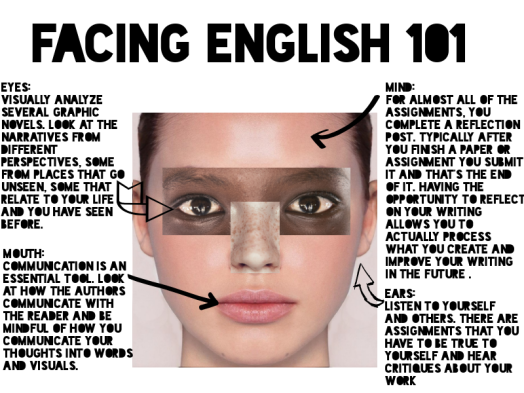
Mapping Spinning
Each chapter of Spinning opens with an explanation of a different figure skating move and Tillie’s experiences with it. My understanding of this aspect of Spinning was definitely altered when I visualized it through the map I created. When I was reading Spinning, I simply viewed the chapter headers as a cute and clever way of incorporating each chapter while simultaneously giving the reader insight into Walden’s perspective. However, when I looked back and focused on the openings of each chapter I began to notice that as the novel progresses, so do the complexities of the figure skating move. These complexities also carry over into her life experiences and relationships with those around her. Tillie is not only growing up physically, but also handling more and more mentally. That’s why I decided to represent my map the way I did. I filled each chapter number with the move that Tillie assigned it and had the numbers grow in size, similar to Tillie. I decided to focus on this element of Spinning, because I wanted to see if there was a deeper meaning behind these chapter headers and a connection to the emotions that Tillie was trying to evoke throughout the novel. I think I was very successful in creating my map as it’s easy to follow and conveys the same message Tillie portrays in a new and creative way.
Data Visualization
For this data visualization project, I decided to track my phone usage and specifically compare the average amount of time I’m on my phone during the week versus the weekend. In the beginning of the year, I downloaded an app called “moment”. The app tracks how much I use my phone each day and when and where I use it. The app also sends reminders indicating whether I’ve spent more or less time on my phone compared to the previous day. I find that it’s very useful and definitely gives me an idea of how to balance screen time and real time. The reason I downloaded the app in the first place is because while I was at the airport, I looked around noticed that the majority of people’s heads were down looking at their screen; parents neglecting their kids, spouses sitting in silence, siblings in their own little worlds. I was horrified by what I saw, but also aware of the fact that I’m guilty of the exact same thing. Then I wondered just how much time I spend on phone. I wanted to make myself aware of exactly how often I was on my phone and not in the present “moment”. For this project, I was hoping to track which apps I used most often, however I had to upgrade the app and pay so instead, I decided to see whether I use my phone more during the week or on the weekends.
During the week, I mainly use my phone to check e-mails, listen to music on my way to class, read the news, and text friends to meet up for lunch. I am guilty of using my phone in some classes, despite my best efforts to leave it in my backpack. I’m also in a long-distance relationship, so maintaining communication with my boyfriend definitely plays a role in how much time I’m on my phone. On the weekends, I use my phone to make plans, Facetime family and friends and take pictures of whatever it is I’m doing. I’m typically with my friends so I tend to use my phone less often when I’m with people. I hate when people are on their phones when I’m with them so I try not to be hypocritical. I also don’t have Friday classes so I included Fridays in the average weekend usage. On average, I use my phone 186 minutes on the weekend and approximately 208 minutes during the week. This isn’t what I expected the results to be, considering I’m in class during the week and know that I’m (for the most part) good about leaving my phone in my bag. However, I realized through this process that the time I have in between my classes is brief, and there isn’t enough time to do my homework so I typically end up using my phone to pass the time. I’m definitely going to continue to use this app and try to decrease my phone usage overall. I personally feel that our time on earth is so valuable, so why should I waste it on a fake reality.
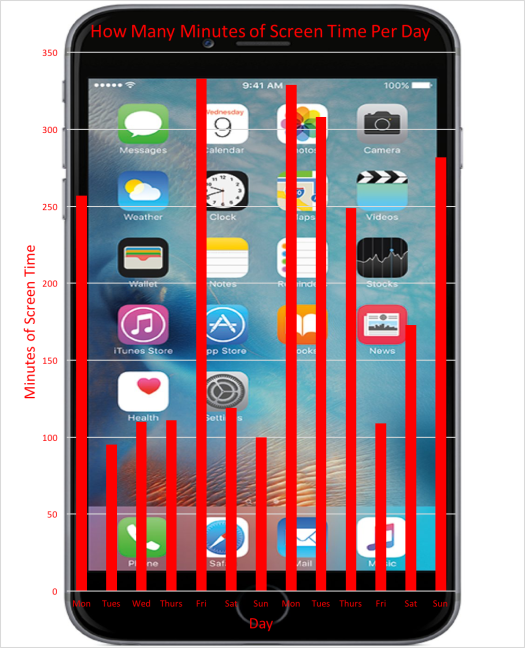
Red Writing Hood
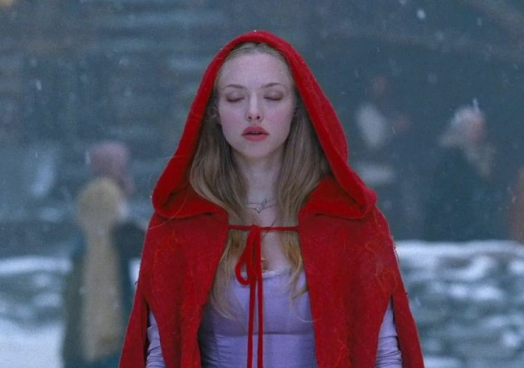
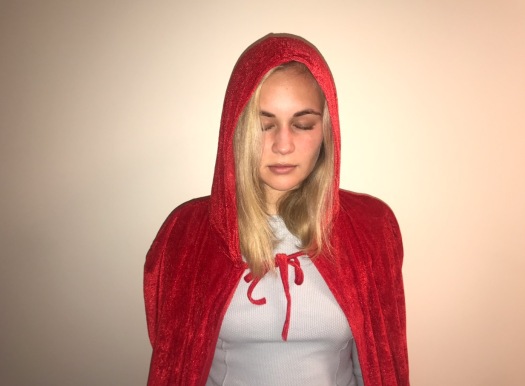
I saw my friends’ red riding hood cape and the rest was history. She also happens to be blonde so it worked out well. I used flash to try and make it brighter like the snow. The part I was unsure of was choosing a background, so I played it safe and went with a plain background.
Literacy Comic Reflection
Once the visual component of my literacy narrative was added, I had a clearer direction for my storyline. I’m definitely going to go back and rewrite or at least revisit my literacy narrative, because the visual helped narrow in on the direction and message I wanted to focus on.
When deciding what to draw in each frame, I focused on either the setting of the scene (i.e. the library) or a line that I could create visually (i.e. “follow in her footsteps”). I realized after creating the comic that I don’t prefer alphanumeric writing because I find it harder to organize my thoughts and find the words that express what I’m trying to convey to the reader. I noticed that none of my frames have people actually talking to one another, and I think that’s because I’m not the best at drawing people. Also, the story is written in the past tense so adding conversations would be switching to present tense, which could be confusing for both me to create and for the reader to read.
One aspect of my comic I tried to portray was how the lamp was bright when my mom was healthy, and then everything went dark after she was gone. I didn’t use words to express that and left it up to the reader to figure out. I also used less detail as the story went on to symbolize the emptiness in my life without my mom’s presence. I took up both of the last two frames for dramatic effect and to try and represent a moment with a greater and significant impact.
Combophoto
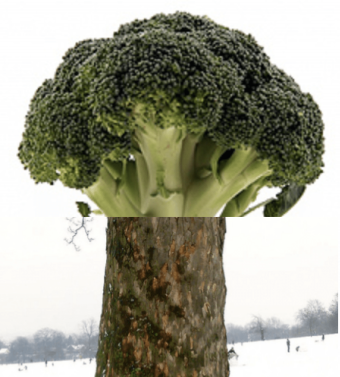
Scrolling through Mcmennamy’s pictures, I was drawn to the majority of the pictures that included food. I recently started a foodstagram (instagram that showcases my pictures of food) and started thinking of how I could incorporate some of these s=combo photos into my feed. I’ve been eating a lot of broccoli lately because I don’t eat bread during passover and I find that broccoli is quite filling. So I searched broccoli and started thinking of what broccoli resembles. That’s when I thought of a tree trunk. I also like how the bottom picture of the trunk takes place in the winter time while the top picture of the broccoli is bright green as if it’s spring or summertime. A challenge I had putting these two images together was the sizing and lining them up so the image appeared as more cohesive and fluid. This final image conveys the life of a tree in different seasons and a vegetable branching off and finding new roots.
Tell A True Story
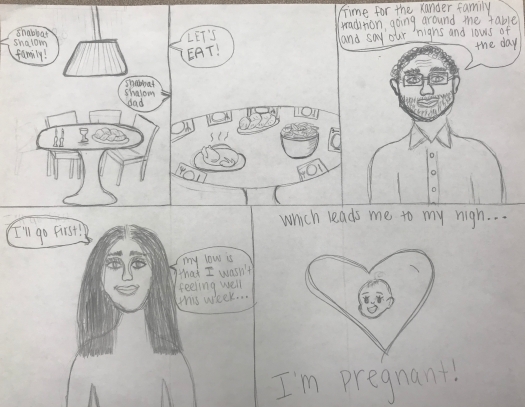
At my family’s shabbat dinner, my sister in law announced that she’s pregnant! Choosing to write about this story was pretty easy, because it’s a pivotal event in my families life. I found this story challenging to draw and turn into a comic, because I had to adjust the story slightly in order to make the story clear and cohesive. For example, she was actually the last to tell her “high and low,” but I wasn’t going to share everyones highs and lows before getting to the key part of the story. An important choice I made in creating the comic was making the bottom two frames bigger than the rest because those are the more dramatic and significant parts of the narrative.
Colin Combs Sketch

I was drawn to this image, because I’ve always been fascinated by the idea that cameras can’t always capture what we see. As much as I wish I could capture a moment and save it to my camera roll, I like the fact that some things can only be seen with my own two eyes. I recently went to a concert and whipped out my phone to take a video of the song and the performance. I later looked at the video and noticed a sea of phones doing the exact same thing. So much of this new age, iPhone centered, culture is about taking videos and pictures to keep or share. But I’m starting to realize that these moments are being lived and seen through my phone and not by me. As I spent time sketching this photo, I noticed that the girl is taking the picture of the fireworks, but the visual doesn’t pan out or replicate what she’s probably seeing. I also noticed that the picture itself couldn’t capture the entirety of what was going on (the specks of light in the middle and the fireworks on the bottom). However, what makes this photo “art” is the idea that you can interpret the image as you please. Things and moments don’t have to be as they appear, otherwise there’s no room for imagination.
